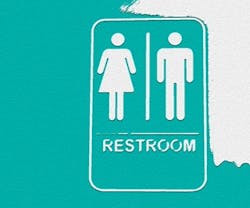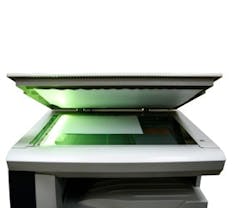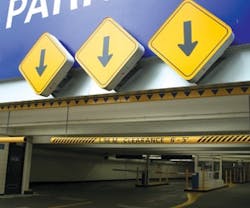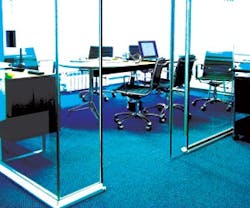1.Constantly Clean
Fluor Enterprises, Inc. has adopted daytime cleaning in order to save money. The scope of work involved 590,000 square feet and provided an annual cost savings of $130,000. Their benefits didn't stop there, though. "The real benefit comes in the form of utility cost reductions," says John Sorich, director of office services for the California company. "The old model had lights on in the facilities until approximately 2:30 a.m.; the new model has lights off at 9 p.m."
2. Climate Control Crisis
Occasionally there are climate issues where there are differences in temperature within a common space. In these instances, the problem may be related to the operation of the outside air handling units. "For those OAHU systems with fan coils that operate either 100% open or 100% closed, closing outside air dampers to the units will substantially contribute to making the space feel cooler in the summer or warmer in the winter," says David Campbell, facility plant operations manager at the Higher Education Center in Mckinney, TX. "Another option in humidity control for these systems is to regulate the discharge air temperature to remove or add humidity to the space."
LED technology has advanced, which now gives these lights the ability to be used for general overhead lighting. "My tip is to replace fluorescents with LED ambient lighting to reduce maintenance costs, reduce energy, and achieve sustainability goals," says Jeffrey Herr, administrative analyst/specialist in the Physical Plant Department at San Diego State University. "At San Diego State University we converted a 5,800-sqare-foot gymnasium into a 215-person lecture hall. As part of the construction, we used LED lighting for the entire lecture hall, including downlighting and ambient lighting. "While it is too early to give concrete results (the project was completed in mid-July), the school will be calculating the energy, maintenance, and sustainability benefits of the LEDs."
You can save several thousand gallons of heated water per day when you pipe the DHW recirculation pump suction lines down and across the wall stops in each restroom stack instead of putting recirculation line taps above the ceilings. Placing the taps in the ceilings, up to 25 feet from the point of use, causes continual batch waste of 0.5 to 1 gallon of warm water per lavatory that goes down the drain before the water warms up at the point of use.
"This constitutes a needless waste of energy and water, one that could be avoided through the use of heat tape or proper circulating of the recirculation lines so that the distance between warm water and the point of use is less than three feet of small diameter drop extenders from the ¾-inch wall stops," says Craig Hofferber, executive vice president of H&P Systems, Inc., a California-based consulting company. "When using electric water heating for lavatories, it is almost enough to just use heat tape and an instantaneous water heater to make up the continuous demands over about 2 GPM." The heat tape can recover the slight loss in temperature unless there is a large demand, in which case the instantaneous unit kicks in.
When you're performing with the bare minimum, you need to come up with an innovative way to get all needed tasks done. Lynnette Boyle, property manager with Michigan-based PRS Management Services, has done just that. "I use my entire staff to take on odd tasks while we are on a skeleton crew," Boyle explains. "My security guard keeps a temperature gun and walks suites in vacant buildings to get temperature readings so that we know if the maintenance staff needs to make sure the heat is working in the winter. They also keep hand-held vacuums to clean up before a 'prospect showing.' The guards are happy to help."
Why limit cleaning to when the office space is unoccupied? State Farm Insurance uses a combination of daytime and cooperative cleaning to save as much as 27% on cleaning costs and 8% on lighting costs each year. "The program includes cleaning the high profile areas before the building opens each morning," says Steven Spencer, facilities specialist in State Farm's Facilities Management Department. After the buildings open, the restrooms are cleaned continually while break areas, entryways, and conference rooms are cleaned on a set schedule and with high-productivity equipment. In addition, "employees take their food waste to a collection area daily and additional trash can be disposed of when they deem necessary."
At the Community Association Underwriters, Inc. Headquarters Building, Cricklewood Realty Investments, LP. implements what they call "cascade maintenance" after motors or electrical components need major repairs and there is no clear cause of failure. "Similar components in the area, building, or similar process are inspected for any unusual wear since the previous preventive maintenance inspection," says Daniel Snyder, property manager for Pennsylvania-based Cricklewood Realty Investments, LP. "Power quality is often the culprit, so motor starters, contactors, transformers, and fuses are tested to reduce the potential of downtime for pumps and fans. The likely causes are utility power fluctuations or equipment failures, which introduce voltage sags, surges, or transients that damage sensitive components." Catching a problem before it becomes larger will save you time and money.
Using weather-based irrigation controllers instead of traditional ones is a wise water management practice. "Smart controllers adjust irrigation watering times based upon actual weather conditions, for example, watering less when it's cloudy and cool and more when it's warmer and drier," says Dennis Kaiser, communications senior manager with California-based ValleyCrest Landscape Companies. When used and applied properly, and in conjunction with other water management practices – drought tolerant plantings, drip irrigation, hydrozoning, and storm water management techniques – you can make a significant difference in the amount of water being used. "Beyond environmental stewardship benefits, smart controllers help reduce water bills for owners, improve plant health, and reduce water-related damage to roads, sidewalks, and other site elements," he says.
Using anywhere from 10,000 to 15,000 gallons of water per night for irrigation, Sawgrass Country Club in Ponte Verda Beach, FL, has the potential to save a tremendous amount of water in just a few nights of savings. To help conserve water, they created a device that allows them to wirelessly manage their irrigation system. "Our device is wired to our irrigation controller and allows me to send an email to the irrigation clock to turn it off, without having to dispatch an employee to manually turn the system off," explains Matt Durkee, the golf course maintenance superintendent at the Sawgrass Country Club. "It is also used for freezing temperatures at night to avoid icing over walkways and parking lots, eliminating liability for such conditions." In addition, a flow meter emails Durkee's computer each time the system runs, stating how many gallons have been used. This allows him to pinpoint irrigation breaks and malfunctions. "If I see we ran too much on the previous cycle, we can dispatch our technician to the proper zone to troubleshoot, so that a broken pipe or irrigation head does not go undetected."
HVAC contractors who service buildings are often underutilized in commercial buildings. Looking for the cheapest preventive maintenance contract may seem like an easy way to save money, but finding a contractor with an energy focus may end up saving you more – even if that contractor may be more expensive. "Use ENERGY STAR benchmarking as a way to qualify your contractor," says Tim Kensok, vice president of market development with Oregon-based AirAdvice, Inc. Test the energy knowledge of contractors by asking them to provide a benchmarking analysis of your building's current energy performance, including any ENERGY STAR performance rating. "Any 'energy-enabled' contractor should be happy to provide this. If they don't know how to determine the ENERGY STAR rating of your building, it should call into question their capability to provide more than basic maintenance and repairs."
If your current contractor can't help you, find one who can. "It may cost you a little more, but think about it – saving just 10% of your energy spend is probably more than the entire cost of the maintenance agreement. A contractor who can help identify 10% energy savings is far more valuable than one that charges 10% less for a PM agreement."
When outsourcing a task, hire two different companies out of the bidding pool instead of one. This allows you to create some healthy competition and for you to get the best results. At the Pensacola (Florida) Civic Center and Pensacola Saenger Theatre, Company A and Company B were each asked to provide half of the cleaning crew. If either company was short people or provided inappropriate people, it was noted the amount the company was deficient and altered for subsequent calls. "For instance, if Company A was short 5% of the 50% they were to provide, then on the next call we asked Company B to provide 55% of the call and Company A to provide 45% of the call," explains Jim Kerrigan, director of operations with SMG, the management company that runs these venues. "This way either the stronger company works the deficient one out of a job, or both increase in quality because they're concerned about losing the business."
Instead of running the water-wrapped coils from hermetic compressors on dietary coolers, the Tift Regional Medical Center now pipes the water-wrapped coils into their cooling towers, supplementing the water makeup with this water injection. "Instead of dumping water down a drain, we use it now for makeup water," says Don Gay, director of maintenance at Tift Regional Medical Center in Georgia. "This has saved the hospital on average 13,000 gallons a day in makeup water."
To keep buildings running at peak performance, the Massachusetts Institute of Technology (MIT) has an outside firm with building automation system (BAS) expertise monitor points from the BAS in some of its larger buildings. The monitoring firm uses proprietary software to look for anomalies in the performance. An engineer then studies the anomalies to determine their validity and cause. The department gets a monthly report that brings attention to the issues, which are then assigned to an engineer for investigation and resolution.
"Significant savings have been identified and solutions implemented," says Walter Henry, director of engineering for MIT's Department of Facilities." We learned that a significant portion of our operational problems have been created by our own staff, who have a single-minded objective to fix a problem while unintentionally creating another, often larger. We have now instituted rules for our HVAC technicians that limit the changes that they can make without engineering supervision."
No longer operating out of the barn where it began, Spacesaver Corporation, a subsidiary of Krueger International, has grown from its grass roots but still manufactures out of a moderately aged facility, a portion of which is heated by infrared (IR) heating units with wall-mounted thermostat control. "Obviously these units were exposed to daily modification by plant personnel with varying degrees of personal comfort throughout the heating season," says John Gray, technical service team member for the Wisconsin-based firm. "At times these units would be left on at night and over weekends at temperatures that did not support good energy management. We also found that as we automated temperature control in other parts of the building, these IR units would 'fight' the automated control and attempt to compensate for the programmed – and desired – unoccupied temperature setting."
To combat this problem, the company began looking for a low-cost alternative to replace the manual thermostat and found a reasonable Ethernet capable temperature controller and power supply. "The total cost was less than $150 per retrofit," Gray says. "In addition to the networked 'smart' controllers, we also wrote a simple control interface, utilizing one of our automation engineer's software development know-how. Now, our plant maintenance staff has desktop access and control of the IR heating units through the Ethernet controllers and software interface." After retrofitting six IR units with the networked controllers, the company is experiencing a payback measured in weekends and plans to complete the retrofit on all remaining units by this year's heating season and then move on to the warehouse locations. "It's a great homegrown solution and energy management initiative, albeit on an outdated heating system. We take our wins where we can!"
Save by installing a separate meter on the water supply that serves your facility's cooling tower. "Most municipalities charge for sewer service by tying it to the amount of water used," explains David McMillan, vice president of facility planning and construction at North Carolina-based Novant Health. "By metering the cooling tower water that is evaporated, the sewer component of that bill can normally be eliminated."
The introduction of a used furniture model can help save your company money, as it did with California's Fluor Enterprises, Inc. "This involved moving from the traditional practice of purchasing new furniture to purchasing quality used/refurbished furniture," says John Sorich, director of office services for Fluor Enterprises, Inc. "With the introduction of this model, we have achieved a cost savings of approximately $3,200 per typical 8x8 workstation. More importantly, our employees have been extremely satisfied with the refurbished solution." If you can keep your employees happy with their workstations at a fraction of the cost, why not take the refurbished route?
While facing tighter budget constraints and increased responsibility for employees, the began an initiative that has proven to be successful. TheyLewisville (TX) Facilities Services Dept. call it the "classroom blitz." Using this method, the facility's department suspends normal operations for three days at the beginning of the summer break and personally walks through and inspects each of the almost 4,000 classrooms in the district, making note of anything that needs repair, replacement, or some kind of attention – floors, ceilings, walls, windows, casework, lockers, plumbing, etc. The staff then spends the next six weeks performing work on the documented items. Two weeks before the start of school, the facility department devotes three days to repeat the classroom inspections in order to ensure that all items have been resolved and nothing new has surfaced. "This effort was successful for a number of reasons," says Larry Williams, Assistant Superintendent, Facilities and Construction, Lewisville I.S.D.
1. "It does not require additional staff to carry out – existing staff was ample for the task.
2. It does not require a budget increase as the needed work was part of our routine task.
3. It saved money because the facility staff discovered some problems in an early stage and was able to correct them before they became much bigger.
4. This effort better connected the facility's staff to the classroom learning environment – we don't stand in front of a classroom and teach kids, but we play a vital role in the education process by keeping the classroom and building in a good and proper condition, allowing the trained teaching professionals to do their jobs."
Small improvements can have a big impact on energy savings. "We have found that even the smallest investment in off-the-shelf programmable thermostats shows great energy savings when properly installed and programmed," says Wallace Brady of Wallace Maintenance. "One of our facilities has seen an almost 50% savings in electricity costs alone over the last two years, with little noticeable difference to occupant comfort."
Replace your handsink faucets in order to conserve water, and money. "A simple, cost effective way to save 15-30% of water usage is to replace all existing handsink faucet aerators with a 1.0 GPM Compensating Spray Aerator," says Mike Gent, principal of KMG Restaurant & Retail Development Consultants and franchisee of SONIC. This provides an even "showerhead" flow at 1.0 GPM and is vandal proof.
Even when converting the faucets with a thread adapter, the cost per faucet is usually less than $10. "We've dropped water usage by as much as 30% in locations with 5 handsinks where we've made this simple change. Even faucets that already have flow control aerators are replaced, as the 'showerhead' design provides more efficient washing and rinsing for the user." Gent also experiences less maintenance, as these aerators are not as susceptible to clogging or theft/vandalism.
Not only should you practice preventive maintenance in your building, you should make sure your staff is prepared as well. What happens if a natural disaster or rolling black out hits? You need a way to contact your tenants or vendors when you no longer have access to Outlook or your Blackberry. "I have a simple answer that helps you contact the necessary people in case such an occurrence happens," says Marisa Knox, property management coordinator with California's Crown Realty & Development. "My tip is to make two folders. Print out all of your contacts from Outlook: vendors and tenants, emergency contacts, etc. Keep one folder at home and one in your car. Emergencies don't usually happen during business hours, so having this hard copy form with you in your car or at home is vital." A hard copy is great if your computer crashes and your files aren't backed up, or if you have cell phone problems.
Arizona's Maricopa County Facilities Management Department electronically advertises its construction and related professional services. "Vendors are sent a broadcast that a new advertisement has been posted," says Lynda Cull, Article 5 procurement officer. "Interested parties follow the imbedded link from the e-mail and review the project information online. If they are interested in downloading the documents, request for qualifications, addenda, bid packages, etc., they log in with their password and download the documents." Everyone can see an automatically created "plan holders list" and all relevant procurement information is posted for download by anyone who needs to see it. "Facilities Management Procurement is also moving toward electronic submissions for bids and statements of qualifications in an effort to further cut down on fuel emissions, paper usage, and file storage."
Carter has found a cost-effective way to stop its employees from overriding motion sensors in the room layouts where sensors don't pick up movement and shut off the lights – even if the room is occupied. Often in these situations, people override the sensor, which will remain overridden and the light will stay on until an engineer goes back into the room. "The solution we have used for these situations is a wireless motion sensor that you can place on the ceiling around the corner to pick up movement," says Rene Serrano, chief engineer for Georgia-based Carter. "The motion sensor is synchronized with the light switch on the wall. For larger rooms you may connect another sensor to the same switch to cover more ground. We have discovered that our payback comes out to about a year and reduces electrical consumption by more than 20%."
Asking staff to perform tasks not in their job descriptions requires flexibility and practicality. "It would not be practical to use house engineering and cleaning staff to convert the building during a heavy show week – we do resist the notion of what is and what is not our job," says Jim Kerrigan, director of operations with SMG, the management company of the Pensacola Civic Center and Pensacola Saenger Theatre. "By assigning task-oriented structure, crews from different disciplines can assist one another. For instance, on a show day, the production staff takes the lead and housekeeping and engineering support production. During a deep clean on an off week, housekeeping takes the lead, and production and engineering support them." This strategy is made possible by cross-training employees. "Housekeepers should be knowledgeable of the building production and engineering equipment. Production should be knowledgeable of engineering and housekeeping equipment, and so on."
Both Aflac, a Georgia-based insurance company, and Hines, a Texas-based international real estate firm, use occupancy sensors in parking garages to reduce their utility expenses and their carbon footprints. Jack Beuttell, global sustainability manager for Hines, cites an example of a facility in Texas, which has a 12-floor garage with 1,920 32-Watt bulbs that operated 24 hours per day. "In an attempt to save electricity, we experimented with occupancy sensors for each floor," he says. "After some trial and error, we found a combination of 20 sensors effectively covered an entire garage level, including elevator lobbies and stairwell doors." Safety was the company's top concern, so emergency lights were not connected to the system, ensuring that the garage would have minimal light levels in case the system fails.
"Each garage level was divided into two zones, causing half of the floor to light whenever an occupancy sensor is activated," he explains. "This system was first installed on the top level of the garage. To test the system's effectiveness, a meter was installed on each zone and data was recorded for two months. For the first 30-day period after the installation, we found the lights were only on for 115.5 hours, versus 720 hours during each prior month. Based on this data, the payback for the initial $4,875 invested per floor was calculated to be approximately 7 months." Hines has since installed sensors on five other floors in that garage, with lower payback calculations (up to 15 months) on the lower levels due to increased traffic.
If you are interested in taking this route, note that each garage will be different based on the size and shape, so different sensors should be tested in a sample area before a large-scale roll out.
The Maricopa County Facilities Management Department in Arizona uses Energy Performance Contracting to ensure that its buildings are operating at peak efficiency, and the lighting, water, controls, and HVAC systems are as up to date and energy-efficient as possible. "You begin by entering into an agreement with an energy service company (ESCO)," says Neil Urban, a senior planner in capital facilities development at the Maricopa County Facilities Management Department. "The ESCO will conduct an Investment Grade Utility Audit of your facilities and then recommend energy saving improvements to be paid for through savings. The ESCO will guarantee that the savings meets or exceeds annual payments to cover all project costs."
APS Energy Service recently completed a utility audit for Maricopa County that identified $26 million worth of energy savings projects in 132 buildings. The county is currently working on the almost 300 projects that were identified in the audit and is on target to complete the projects within 19 months. "When completed, the projects will save Maricopa County nearly 10% per year on its annual $20 million utility budget." Two million dollars is nothing to sneeze at! How much could you save by using Energy Performance Contracting?
Windsor Police Service in Windsor, ON, has found that letting a significant amount of the landscaped areas at its large, comprehensive police training facility "go natural" for much of the year has resulted in better moisture retention for the lands, reduced runoff and erosion, and less maintenance costs. In addition, this practice represents a more environmentally sustainable manner to maintain the property. It conducts a twice annual (spring and fall) "weed whip" cleaning that keeps the plants reasonably trimmed. Otherwise, the grasses are allowed to grow. "Of the site's 17 acres, approximately 5.5 acres are built space, while the remaining 11.5 acres are green/soft landscaped space," explains Barry Horrobin, director of planning & physical resources with Windsor Police Service. "Of the 11.5 acres of green space, approximately 75% is subject to naturalization, resulting in significant operational maintenance/cost savings, enhanced environmental quality, and the creation of a habitat that has sustained the likes of native Carolinian Forest species, foxes, deer, squirrels, chipmunks, snakes, and other animals."
Some building managers want to go through a relamping project all at once, instead of replacing lamps individually as they burn out. By doing this, the burning rate is reduced, but the non-burnt lamps go to waste. Applied Engineering Solutions, Ltd., in Vancouver, BC, came up with a solution for this problem. "I suggested to a building manager that the contractor doing the relamping be asked to put all used lamps in the packaging of the new lamps," says Ahmet Ulker, vice president of Applied Engineering Solutions, Ltd. "Later the local Salvation Army store was called and told there were a lot of used lamps that were packaged and could be picked up. These lamps were put on sale by the Salvation Army for a fraction of their cost, after saying that they were used and some might be burnt. The lamps were quickly sold to homeowners who did not mind changing their lamps." There are several benefits that come from recycling the lamps in this way: good lamps are recycled, it saves additional lamps (and the mercury associated with them) from the landfill, the Salvation Army made money, and homeowners got used – but cheap – lamps.
When you're a 24/7 operation like a hospital, jail, headquarters, or command center, snow removal can be a heavy burden, and one that the Northern Virginia Mental Health Institute in Falls Church, VA, knows all too well. It has found a proven strategy that works well for the 3-shift hospital. "Before the winter storm approaches, clear out and then cone off 1/3 of your staff parking lot," says Donald White, directory of safety and security for Northern Virginia Mental Health Institute. "When the snow arrives, you can quickly and completely plow that section, curb to curb. Repeat this process for the remaining two shifts, alternating one section per shift. End result? Each 24 hours your entire parking lot gets quickly and completely plowed without any obstructions."
There are simple ways to educate building occupants. Chris Folts, director of building services for Livingston County in Michigan hangs educational, laminated cards over the light switches in county buildings. "I make laminated cards that say 'Did You Know' at the top of the card and then a short message – 'Did you know lighting accounts for 30 to 50% of a building's energy use, or about 17% of total annual U.S. electricity consumption? Simply turning off unneeded lights can reduce the amount of energy used by up to 45%. At the same time, using less energy reduces air pollution, global warming, and other environmental impacts associated with electricity generation.'" Sometimes knowledge can mean using less power.
"Education" doesn't have to occur in a classroom setting – it can happen informally as well. "We have to keep our minds and ears open for newer practices and more efficient ways of doing things," says Gregory Carbone, vice president of property management for Trefoil Properties, LP, Trefoil Management LLC, and Tremark Management, Inc., all Pennsylvania-based. "A good example occurred with the sustainable movement – early learners had a jump start because they kept informed and were open to being exposed to fresh ideas." Networking is an effective way to stay educated. "I've got a group of folks that I've met over the years who are invaluable, not just for networking, but for bouncing new ideas. They are not just in facilities or property management, but in other areas of finance and legal. It's nice to ask for perspective and not have to pay an hourly rate for it."
Kohn Pederson Fox Associates PC in New York City is saving money by reducing paper usage and printing. How is it doing this? It organized its studio space, principal offices, and conference rooms to allow multiple users to view and discuss drawings. "At each workstation, a large LCD display is mounted on a movable arm to encourage sharing screen images," says Krissie Nuckols, public relations manager for the firm. In addition, employees can use digital annotation tools to review and comment on drawings that are on the screen. "The monitor system and the implementation of visual technology to view and modify the drawings electronically has significantly reduced the amount of printing, thereby lowering cost, paper use, and time spent printing."











